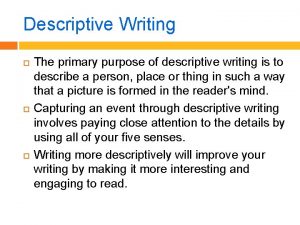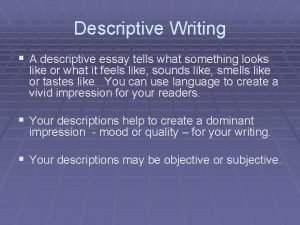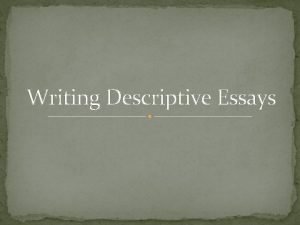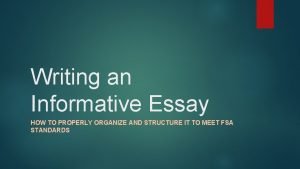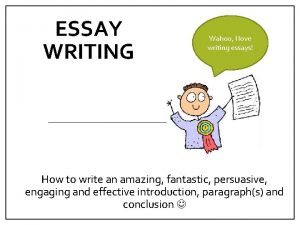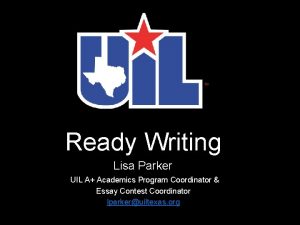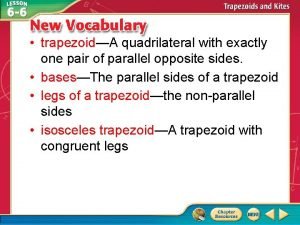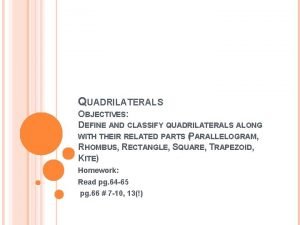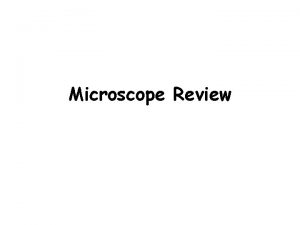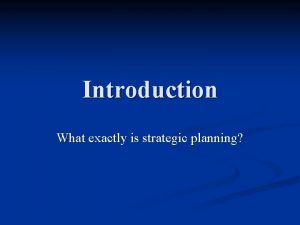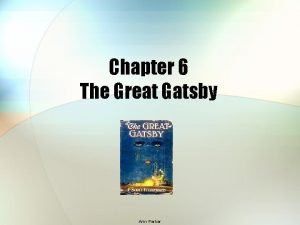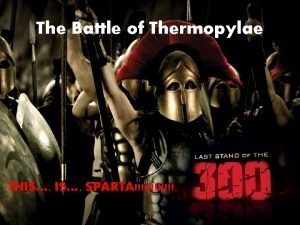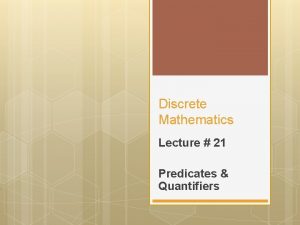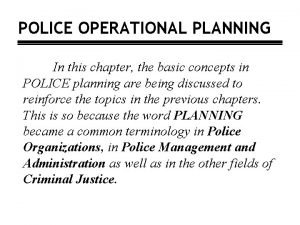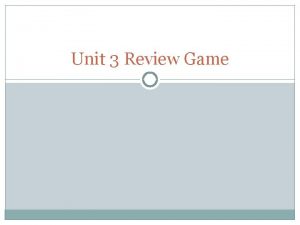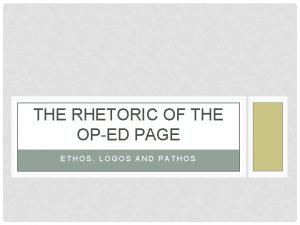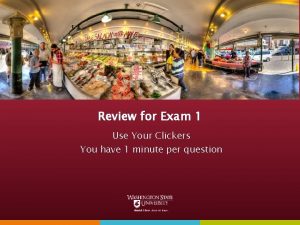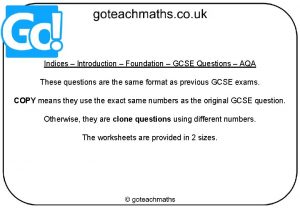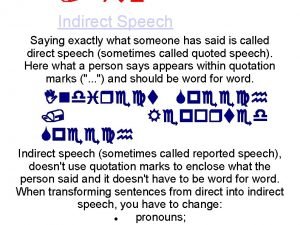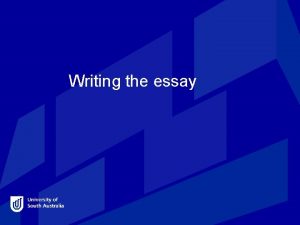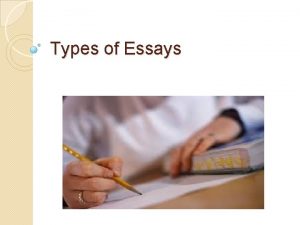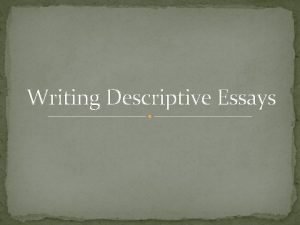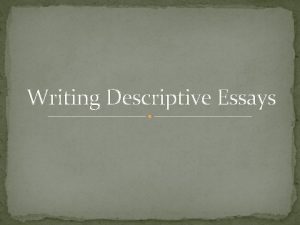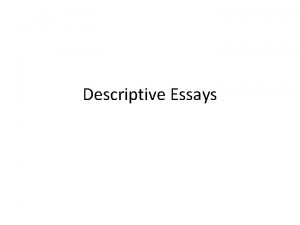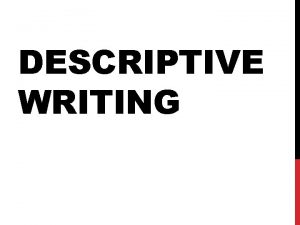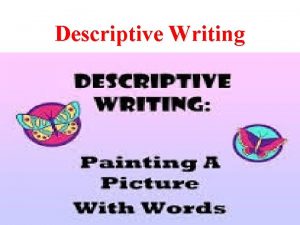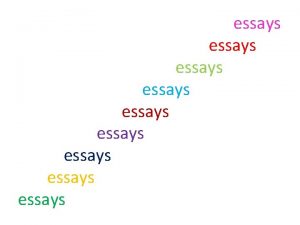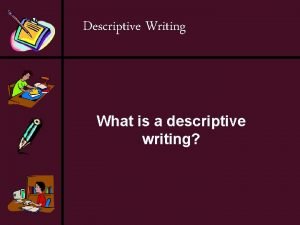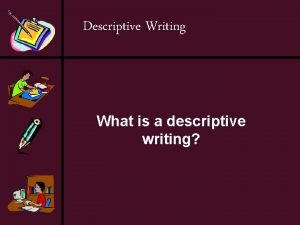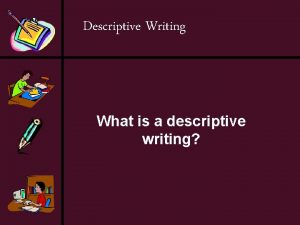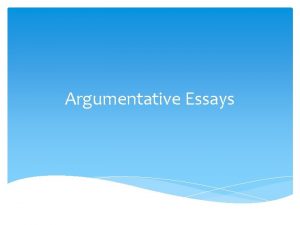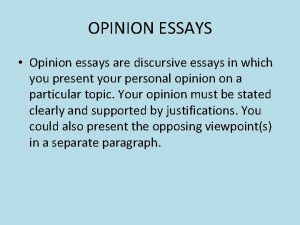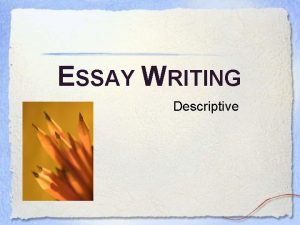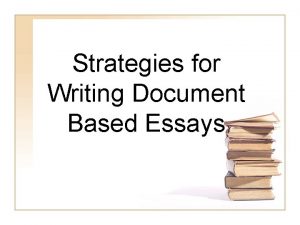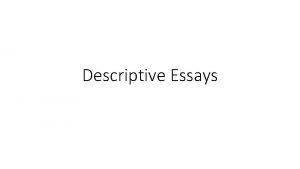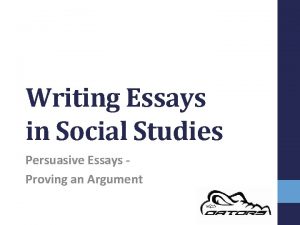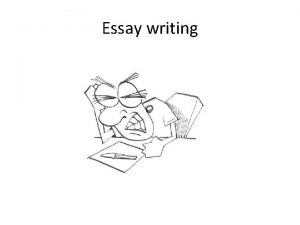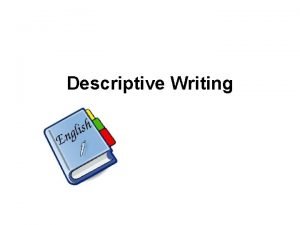Writing Descriptive Essays What exactly is a Descriptive






























- Slides: 30

Writing Descriptive Essays

What, exactly, is a Descriptive Essay? A descriptive essay is simply an essay that describes something or someone by appealing to the reader’s senses: sight, sound, touch, smell, and taste.

In a descriptive essay, you are expected to describe a person, an object, or an event.

Steps to writing an effective Descriptive Essay: 1. Select a subject - Observation is the key to writing a good description. For example, if you are writing about a place, go there and take notes on the sights, sounds, and smells. A descriptive essay paints a picture for the reader, using descriptive devices and the senses.

2. Create a thesis statement – A thesis statement is simply a sentence that tells the reader what you are going to be talking about throughout the entire essay • You’re thesis statement should never begin with phrases like, “I am going to be talking about. . . ”

• Since this is a descriptive essay, create a thesis that informs the reader of who or what you will be describing. Ex: “My bedroom is an ocean sanctuary” Ex: “My family vacation to Disney World was a magical week of fun, laughter, and sun-filled happiness.

Select dominant details - Make sure you are only writing about things that specifically support your thesis. 3. For example, if your thesis statement is talking about your sun-filled trip to the beach, don’t bore the reader with meaningless details about your swimsuit. . . You should be describing the beach itself, and perhaps some of the events that took place there (e. g. building a sandcastle, boogie-boarding, parasailing, etc. )

4. Use descriptive words – do not use vague words or generalities (such as good, nice, bad, or even beautiful). • Think about it. . . Which sounds better? “I ate a good dinner. ” Or “I devoured a steaming hot, cheese-filled pepperoni pizza for dinner. ” See the difference?

5. Provide sensory detail - Smells that are in the air (the aroma of freshly brewed coffee) - Sounds (traffic, honking horns, waves crashing) - Sights (“The sun scattered tiny diamonds across dewcovered grass as it peeked out from beyond the horizon. ”) - Touch (“The texture of the adobe hut’s walls resembled coarse sandpaper. ”) - Taste: sweet, sour, salty, bitter, tart (“Giant goose bumps formed on my tongue when I accidently bit into a sliver of lemon. ”)

Strategy of Good Writing - Including Sensory Details: A good writer provides the readers with sensory details. Sensory details are details that awaken the reader's senses. Such details are particularly important in descriptive writing. They help readers experience the writer's personal reactions and feelings. For example: "Leaves rose into tiny whirlwind, old newspapers tumbled wildly down the street, and every flag stood at attention"

provides readers with a much clearer picture than "It was windy outside. " REMEMBER, the most effective writing is writing that the reader can experience. To make your writing more effective, include lots of sensory details.

6. Draw a logical conclusion - The conclusion may also use descriptive words; however, make certain the conclusion is logical and relevant.

Now let’s practice! On a blank sheet of paper, look at the following images. Write down things you might hear, see, taste, smell, or feel/touch if you were “in” these pictures After you have compiled a brief list of sensory details, write a descriptive sentence about each picture.






Introduction (Should start with a strong opening which may be a quote that catches the reader’s attention. At the end of the introduction the writer provides a thesis statement related to the depicted object, person, situation, experience, etc. In thesis statement the writer reveals the reason he describes a certain object, person or situation).

Paragraph 1 - The object itself (here the author reveals everything that he perceived referred to the object, person or situation he is describing. The author lists all the details which are important for making a vivid portrait. Uses metaphors and comparison).

Paragraph 2 - The surroundings (The author has basically to show the reader all the surrounding of the described object, person or situation. The reader should feel like he is involved in the experience. Uses metaphors and comparison).

Paragraph 3 - Sensual and emotional description (The writer uses his sense of taste, touch smell, sound and sight to make the experience “alive”. In other words here the author needs to “replay” the object, person or situation to the reader. Uses metaphors and comparison).

Conclusion (The conclusion summarizes the physical and emotional attitude of the author to the described object, person or situation. The conclusion restates the meaning and idea of this experience for the writer and the reason he actually describes it to the reader).

The Narrative Essay A narrative essay is a story written about a personal experience. Writing a narrative essay provides an opportunity to get to know and understand yourself better. Narratives provide human interest, spark our curiosity, and draw us close to the storyteller.

In addition, narratives can Create a sense of shared history Provide entertainment Provide insight

Traits of a Narrative Essay Usually written in first person – “I” Usually rely on concrete, sensory details to convey their point Usually include these story conventions: plot, setting, characters, climax, ending ALWAYS make a point. You don’t tell a story just for the sake of telling…your story must make a point.

Show don’t Tell What does show don’t tell mean? Good writing tends to draw an image in the reader’s mind instead of just telling the reader what to think or believe.

Here’s a sentence that tells. Mr. Bobweave was a fat, ungrateful old man. That gets the information across, but it is BORING.

A sentence that shows… Mr. Bobweave heaved himself out of the chair. As his feet spread under his apple-like frame and his arthritic knees popped and cracked in objection, he pounded the floor with his cane while cursing that dreadful girl who was late again with his coffee. The writer didn’t tell Mr. Bobweave was fat, he showed it by saying his “apple-like” frame.

How can you show your ideas? Use metaphors and similes: She landed under the window like a falling leaf. Use quoted language: bits of conversation can enliven your writing. Know when to quit: If you think your readers would like a little more, write the little bit more and then delete it.
 Descriptive writing purpose
Descriptive writing purpose Transitions for descriptive essays
Transitions for descriptive essays Descriptive essays
Descriptive essays How do you write an informative essay
How do you write an informative essay Objectives of writing essay
Objectives of writing essay Tako texas late
Tako texas late Uil ready writing sample essays
Uil ready writing sample essays A trapezoid is a quadrilateral with exactly one pair of
A trapezoid is a quadrilateral with exactly one pair of Quadrilateral family tree with properties
Quadrilateral family tree with properties Planes of symmetry pyramid
Planes of symmetry pyramid Job design continuum
Job design continuum A student determined that exactly 10 pollen grains
A student determined that exactly 10 pollen grains What exactly is a strategy
What exactly is a strategy What is logistics management
What is logistics management When does james gatz change his name? why?
When does james gatz change his name? why? Regents
Regents Decisive battles thermopylae
Decisive battles thermopylae Everyone has exactly one best friend
Everyone has exactly one best friend Police operational planning examples
Police operational planning examples Introduction to money
Introduction to money A painter has exactly 32 units
A painter has exactly 32 units What exactly is hiasl
What exactly is hiasl Exactly
Exactly Each month jessica buys exactly 15 big macs
Each month jessica buys exactly 15 big macs Qualities of the holy spirit
Qualities of the holy spirit What exactly is plankton?
What exactly is plankton? Show that there are exactly five 3 digit cube numbers
Show that there are exactly five 3 digit cube numbers Definition of segment bisector in geometry
Definition of segment bisector in geometry Language that means exactly what it says
Language that means exactly what it says Saying exactly what someone has said is called
Saying exactly what someone has said is called Example of academic writing
Example of academic writing
